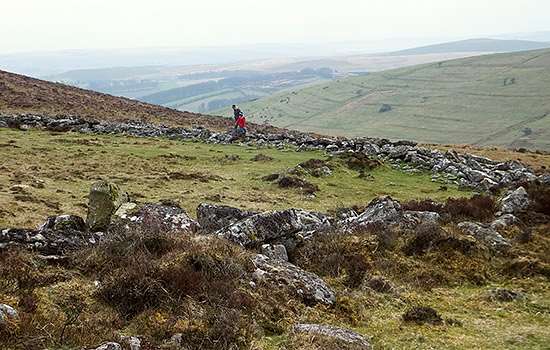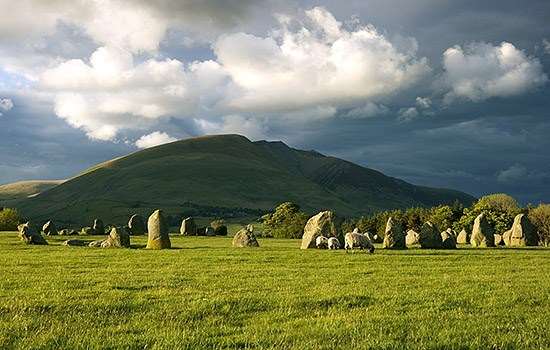Grimspound in the Bronze Age
The earlier Neolithic period, from about 4000 BC, witnessed a transition from a hunting and gathering lifestyle towards a growing reliance on farming. By 2500 BC the early farmers were moving into upland areas like Dartmoor, and settled farms and field systems were becoming commonplace.
The remains of the characteristic roundhouses (also known as hut circles) in which people lived can still be seen across Dartmoor. Sometimes they stand on their own, like isolated cottages today; sometimes, as here, they are grouped together in sizeable villages. Such settlements are a defining feature of the Dartmoor landscape.
We do not know precisely how long Grimspound was in use, but by about 1000 BC the settlement pattern was changing. The people living on Dartmoor had cleared the forest, exposing the fragile moorland soil to erosion. Nutrients left the soil, reducing its fertility, and the moor could no longer sustain the same level of occupation.
Excavations
Grimspound was excavated at the end of the 19th century by the newly formed Dartmoor Exploration Committee.
They excavated 16 of the houses and found numerous structures and artefacts, including porches, paved floors, hearths, raised benches, cooking holes, charcoal, pottery and flint. The distinctive style of pottery helped to date the site to the Bronze Age, but there have been no recent excavations to recover organic material for radiocarbon dating.
The excavators restored parts of the perimeter wall and some of the roundhouses, although not very accurately.
Surviving structures
The great boundary wall is about 150 metres in diameter. Averaging 3 metres thick and standing up to 1.5 metres high, it is faced with large slabs laid in horizontal courses, with a core of smaller stones between the two faces. However, it seems unlikely that it was intended to be defensive. It was probably simply a barrier to keep wild animals out and farmed animals in.
The site overlooks a valley to the north where there was open grazing land, but the original entrance was on the opposite, uphill side. This imposing entrance is flanked by high walls, with a passage 1.8 metres wide, which is roughly paved. A stream running through the northern half of the enclosure would have provided an excellent supply of fresh water, and explains the settlement’s position.
The walls of the houses within the enclosure were probably not much higher than they are now, and covered with conical roofs of turf or thatch. A number of low rubble banks against the internal face of the enclosure wall probably formed sheep or cattle pens.
Immediately south-east of the enclosure, the remains of at least nine more houses survive. All are linked to rubble banks that form part of a field system.
You can climb up Hookney Tor for a good view of the site, and the high ground on Hameldown is another good vantage point.
Further reading
A Guide to the Archaeology of Dartmoor (Exeter, 1996)
Butler, J, Dartmoor Atlas of Antiquities, 4 vols (Exeter, 1991)
Greeves, T, The Archaeology of Dartmoor from the Air (Exeter, 1985)
Griffith, F, Devon’s Past: An Aerial View (Exeter, 1988)
Newman, P, The Field Archaeology of Dartmoor (English Heritage, Swindon, 2011)
Pattison, P, and Fletcher, M, ‘Grimspound, one hundred years on’, Proceedings of the Devon Archaeological Society, 52 (1994), 21–34
Sale, R, Dartmoor: The Official National Park Guide (Newton Abbot, 2000)
Timms, S, ‘“Deep breathing to Grimspound”: archaeologists discover Dartmoor’, Proceedings of the Devon Archaeological Society, 52 (1994), 1–19
Find out more
-

Visit Grimspound
The best known of many Dartmoor prehistoric settlements, Grimspound dates from the late Bronze Age. The remains of 24 stone houses survive within a massive boundary wall.
-

Listen to our audio guide
Our audio guide is designed to be enjoyed whether you are visiting Grimspound or just want to listen at home.
-

Dartmoor’s Historic Landscape
Find out more about all the sites that English Heritage looks after on Dartmoor, one of England’s greatest archaeological landscapes.
-

PREHISTORIC MONUMENTS
England’s prehistoric monuments span almost four millennia. Discover what they were used for, how and when they were built, and where to find them.
